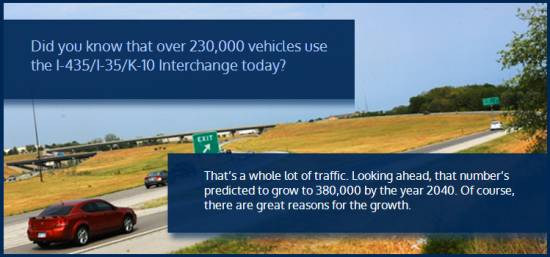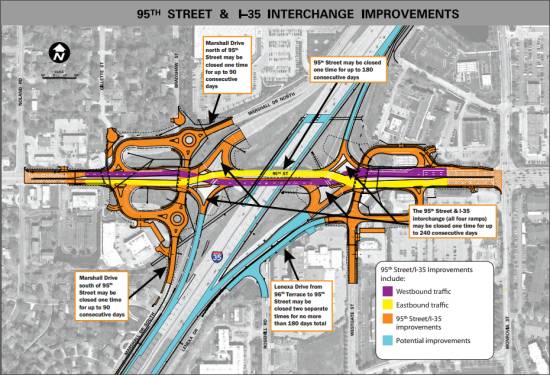The number of miles driven in Kansas has fallen sharply, yet we continue to spend enormous sums of money building roadways that don’t support bicycling and walking for transportation.
The Colorado Public Interest Research Group, a nonprofit, nonpartisan public interest organization, has released a report, Moving Off The Road, that provides a state-by-state analysis of national driving trends. The report “analyzes which states drive more miles per-person, which states have reduced their driving the most since the end of the national Driving Boom, and how state changes in driving behavior correspond to other changes such as growing unemployment or urbanization”.
After sixty years of almost constant increases in the annual number of miles Americans drive, since 2004 Americans have decreased their driving per-capita for eight years in a row. Driving miles per person are down especially sharply among Millennials, America’s largest generation that will increasingly dominate national transportation trends.
Forty-six states plus the District of Columbia witnessed a reduction in the average number of driving miles per person since the end of the national Driving Boom. This study finds that declining rates of driving do not correspond with how badly states suffered economically in recent years. The evidence suggests that the nation’s per capita decline in driving cannot be dismissed as a temporary side effect of the recession.
How has Kansas fared?
In the period from 2005-2011, the average number of per-person vehicle miles traveled dropped by 3.12%.
The “peak” year for Kansas was 2006, and it’s been going down ever since (a total of 4.4% from the peak), to 10,456 vehicle-miles per person in 2011.
And our neighbors? Arkansas -2.50%, Colorado -11.40%, Iowa -2.47%, Missouri -3.45%, Nebraska -5.53%, Oklahoma -5.54%. Everyone’s driving less.
Why does this matter? Because it changes everything about our transportation system!
If we’re driving less and less, then there’s less and less of a need to continue building new roads, and there’s less and less fuel tax revenue for roadway construction, maintenance, and repair (especially once ever-improving fuel economy is factored in).
In other words, a funding crisis is looming.
Which makes it all the more important to invest our limited transportation dollars on projects that are the most cost-efficient, and that have the greatest return on investment, and can positively impact the greatest number of people.
Yep, that’d be bike/ped projects.
That should be no surprise, given some of the conclusions that have been reached in recent years:
- Bicycling infrastructure is incredibly cost-effective. The city of Tulsa, Oklahoma, for instance, determined that a $30 million investment could pay for either one mile of street widening, 600 miles of quality bike lanes, 100 miles of sidewalk, 300 miles of buffered bike lanes, 120 miles of bicycle boulevards, 30 miles of bike trails, or 20 miles of physically-separated cycle tracks. (What will $30 million in transportation funding buy?) Now, which of those choices has the most impact for the largest number of people?
- In urban areas, where cars and bicyclists travel at similar speeds, bike lanes can accommodate 7 to 12 times as many people per meter of lane per hour than car lanes, and bicycles cause less wear on the pavement. [link]
- For the cost of repaving 3 miles of Interstate 710, CalTrans could sign and stripe 1,250 miles of California roads for bike lanes. [link]
- For every $1 spent on bike infrastructure, cities save around $5. [link]
- Roadways require a HUGE subsidy, year in and year out. Drivers pay just 51% of the cost of U.S. roads & highways.
- In Kansas, less than 30% of roadway spending is paid directly by drivers of motor vehicles. The remaining 70% is paid by everyone, whether they drive or not, from general revenue (i.e. taxes). [link]
- The true costs of driving are enormous. CommuteSolutions.org estimates it (as of 2010) at about $1.36 per mile. [link]
- And yet, the vast majority of automobile trips (69%) are two miles or less, an easy distance for bicycling. [link]
- One mile on a bike is a $.42 economic gain to society, one mile driving is a $.20 loss
- 83% of Americans support maintaining or growing federal funding for sidewalks, bikeways, and bike paths.
And yet, despite the clear evidence that we’re driving fewer miles, and the even clearer evidence that we’d be far better off — economically, physically, mentally — biking or walking more, our DOTs continue to assume that the number of cars on the road will endlessly increase, as will the number of miles driven.
And this assumption is used to justify incredible outlays of money, such as the $600 million dollar (and rising) Johnson County Gateway project:

Wasting $600 million in Johnson County:
The $600 million Johnson County Gateway is the project from hell, supposedly paved with good intentions.
This monstrosity of road construction is a multi-year plan to widen Interstate 35, Interstate 435 and Kansas 10, and to expand interchanges and add flyovers where these roads come together. The intent is to handle the greater loads of traffic expected in the next few decades.
And if they build it, the traffic will surely come.
The dollars used for eyesores like the gateway siphon away funds that could be used to construct bike lanes and pathways. Don’t forget that cars rule in Johnson County — and this region.
The Johnson County Gateway is an excellent reminder that, at the end of the day, the real intentions of road planners and highway builders are to create engineering and construction jobs to pour more concrete and build wider roads, while trying to move additional vehicles.
All of these actions lead to — you got it — more expensive highway projects.
Is the JoCo Gateway a boondoggle of epic proportions? Is the entire project built on a very flimsy argument? Well, judge for yourself.
And yet, here we go.
Just a quick illustration of where this thing is headed:
This is the proposed re-design of the I-35 and 95th Street interchange in Lenexa. Currently, it’s a relatively simple diamond interchange. No bike/ped facilities at all, of course.
The new design is slated to be a ginormous Diverging Diamond Interchange (DDI). Again, there are no on-street bicycling facilities planned, at all. But it is supposed to be “pedestrian friendly”, something like this:
This will be the 3rd or 4th Diverging Diamond planned for Kansas. OK, I understand: it’s a new toy, and the engineers want to play with it. But really, is this an appropriate application? Is it really needed to support the ever-decreasing number of cars on the road? Will it be able to be used by the ever-increasing number of people walking and bicycling for transportation?
Does this make any sense whatsoever?
See also: A New Direction: Our Changing Relationship with Driving and the Implications for America’s Future from the United States Public Interest Research Group, and Factors affecting the decline in VMT: A new SSTI report, from the State Smart Transportation Initiative.



Hey now, the one good thing about DDIs is that cars slow down to go through them. The couple I’ve ridden through it’s easier/safer to ride your bike in the traffic lane than try to use the (yes, quite bad) center lane thing since you end up in the correct spot that way.